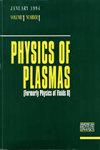具有各向异性离子压力和尘埃电荷波动的实验室和土星 E 环磁化非热尘埃等离子体中的尘埃-离子-声阻尼孤波和冲击
IF 2.2
3区 物理与天体物理
Q3 PHYSICS, FLUIDS & PLASMAS
引用次数: 0
摘要
我们研究了弱非线性尘埃-离子-声(DIA)孤波(SW)和冲击在碰撞磁化非热尘埃等离子体中的斜向传播,这与实验室和太空(土星的 E 环)环境相关。我们认为等离子体是由浸没在静态磁场中的q-nonextensive热电子、热正离子和不动的带负电尘粒组成的,并考虑了离子产生(源)、离子损失(汇)、离子-中性碰撞和离子-尘粒碰撞、各向异性离子压力和尘粒电荷波动对小振幅SW波和冲击演化的影响。利用牛顿-拉斐森方法自洽地确定了离子-中性碰撞增强平衡尘荷数。我们发现,在绝热尘埃电荷变化的实验室尘埃等离子体中[即尘埃电荷频率(νch)远高于尘埃等离子体振荡频率(ωpd)时],DIA孤波(DIASWs)会被离子-尘埃和离子-中性碰撞的影响所阻尼,而离子的产生和离子的损耗会导致孤波的放大,它们仅以正电势的压缩类型出现。另一方面,在土星的 E 环等离子体中,碰撞和离子产生或离子损耗的影响并不显著,尘埃电荷变化的非绝热性可能导致阻尼 DIASW 或 DIA 冲击的演化,这分别取决于 νch/ωpd 或 ωpd/νch 的比率是否很小。此外,非广延性参数 q 存在两个临界值,低于(或高于)这两个临界值,DIASW 和冲击可以表现为稀疏(或压缩)类型。我们还根据与实验室和土星 E 环等离子体相关的参数对 DIASW 和冲击的特征进行了数值分析。本文章由计算机程序翻译,如有差异,请以英文原文为准。
Dust–ion–acoustic damped solitary waves and shocks in laboratory and Saturn's E-ring magnetized nonthermal dusty plasmas with anisotropic ion pressure and dust-charge fluctuation
We study the oblique propagation of weakly nonlinear dust–ion–acoustic (DIA) solitary waves (SWs) and shocks in collisional magnetized nonthermal dusty plasmas that are relevant in laboratory and space (Saturn's E-ring) environments. We consider plasmas to be composed of q-nonextensive hot electrons, thermal positive ions, and immobile negatively charged dust grains immersed in a static magnetic field and take into account the effects of ion creation (source), ion loss (sink), ion–neutral and ion–dust collisions, anisotropic ion pressure, and dust-charge fluctuations on the evolution of small-amplitude SWs and shocks. The ion–neutral collision enhancement equilibrium dust-charge number is self-consistently determined using Newton–Raphson method. We found that in laboratory dusty plasmas with adiabatic dust-charge variation [i.e., when the dust charging frequency (νch) is much higher than the dust–plasma oscillation frequency (ωpd)], the DIA solitary waves (DIASWs) get damped by the effects of the ion–dust and ion–neutral collisions, whereas the ion creation and ion loss lead to the amplification of solitary waves, and they appear as only compressive types with positive potential. On the other hand, in Saturn's E-ring plasmas, where the collisional and ion creation or ion loss effects are insignificant, the non-adiabaticity of dust-charge variation can give rise to the evolution of either damped DIASWs or DIA shocks, depending on the smallness of the ratios νch/ωpd or ωpd/νch, respectively. Furthermore, two critical values of the nonextensive parameter q exist, below (or above) which, the DIASWs and shocks can appear as rarefactive (or compressive) types. The characteristics of DIASWs and shocks are also analyzed numerically for parameters relevant to the laboratory and Saturn's E-ring plasmas.
求助全文
通过发布文献求助,成功后即可免费获取论文全文。
去求助
来源期刊

Physics of Plasmas
物理-物理:流体与等离子体
CiteScore
4.10
自引率
22.70%
发文量
653
审稿时长
2.5 months
期刊介绍:
Physics of Plasmas (PoP), published by AIP Publishing in cooperation with the APS Division of Plasma Physics, is committed to the publication of original research in all areas of experimental and theoretical plasma physics. PoP publishes comprehensive and in-depth review manuscripts covering important areas of study and Special Topics highlighting new and cutting-edge developments in plasma physics. Every year a special issue publishes the invited and review papers from the most recent meeting of the APS Division of Plasma Physics. PoP covers a broad range of important research in this dynamic field, including:
-Basic plasma phenomena, waves, instabilities
-Nonlinear phenomena, turbulence, transport
-Magnetically confined plasmas, heating, confinement
-Inertially confined plasmas, high-energy density plasma science, warm dense matter
-Ionospheric, solar-system, and astrophysical plasmas
-Lasers, particle beams, accelerators, radiation generation
-Radiation emission, absorption, and transport
-Low-temperature plasmas, plasma applications, plasma sources, sheaths
-Dusty plasmas
 求助内容:
求助内容: 应助结果提醒方式:
应助结果提醒方式:


